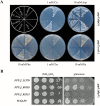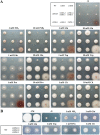The General Amino Acid Permease FfGap1 of Fusarium fujikuroi Is Sorted to the Vacuole in a Nitrogen-Dependent, but Npr1 Kinase-Independent Manner
- PMID: 25909858
- PMCID: PMC4409335
- DOI: 10.1371/journal.pone.0125487
The General Amino Acid Permease FfGap1 of Fusarium fujikuroi Is Sorted to the Vacuole in a Nitrogen-Dependent, but Npr1 Kinase-Independent Manner
Abstract
The rice pathogenic fungus Fusarium fujikuroi is well known for the production of a broad spectrum of secondary metabolites (SMs) such as gibberellic acids (GAs), mycotoxins and pigments. The biosynthesis of most of these SMs strictly depends on nitrogen availability and of the activity of permeases of nitrogen sources, e.g. the ammonium and amino acid permeases. One of the three ammonium permeases, MepB, was recently shown to act not only as a transporter but also as a nitrogen sensor affecting the production of nitrogen-repressed SMs. Here we describe the identification of a general amino acid permease, FfGap1, among the 99 putative amino acid permeases (AAPs) in the genome of F. fujikuroi. FfGap1 is able to fully restore growth of the yeast gap1∆ mutant on several amino acids including citrulline and tryptophane. In S. cerevisiae, Gap1 activity is regulated by shuttling between the plasma membrane (nitrogen limiting conditions) and the vacuole (nitrogen sufficiency), which we also show for FfGap1. In yeast, the Npr1 serine/threonine kinase stabilizes the Gap1 position at the plasma membrane. Here, we identified and characterized three NPR1-homologous genes, encoding the putative protein kinases FfNpr1-1, FfNpr1-2 and FfNpr1-3 with significant similarity to yeast Npr1. Complementation of the yeast npr1Δ mutant with each of the three F. fujikuroi NPR1 homologues, resulted in partial restoration of ammonium, arginine and proline uptake by FfNPR1-1 while none of the three kinases affect growth on different nitrogen sources and nitrogen-dependent sorting of FfGap1 in F. fujikuroi. However, exchange of the putative ubiquitin-target lysine 9 (K9A) and 15 (K15A) residues of FfGap1 resulted in extended localization to the plasma membrane and increased protein stability independently of nitrogen availability. These data suggest a similar regulation of FfGap1 by nitrogen-dependent ubiquitination, but differences regarding the role of Fusarium Npr1 homologues compared to yeast.
Conflict of interest statement
Figures









Similar articles
-
Research progress on the function and regulatory pathways of amino acid permeases in fungi.World J Microbiol Biotechnol. 2024 Nov 25;40(12):392. doi: 10.1007/s11274-024-04199-1. World J Microbiol Biotechnol. 2024. PMID: 39581943 Review.
-
The Npr1 kinase controls biosynthetic and endocytic sorting of the yeast Gap1 permease.J Biol Chem. 2001 Nov 23;276(47):43939-48. doi: 10.1074/jbc.M102944200. Epub 2001 Aug 10. J Biol Chem. 2001. PMID: 11500493
-
Ubiquitin is required for sorting to the vacuole of the yeast general amino acid permease, Gap1.J Biol Chem. 2001 Nov 23;276(47):43949-57. doi: 10.1074/jbc.M102945200. Epub 2001 Aug 10. J Biol Chem. 2001. PMID: 11500494
-
Impact of ammonium permeases mepA, mepB, and mepC on nitrogen-regulated secondary metabolism in Fusarium fujikuroi.Eukaryot Cell. 2008 Feb;7(2):187-201. doi: 10.1128/EC.00351-07. Epub 2007 Dec 14. Eukaryot Cell. 2008. PMID: 18083831 Free PMC article.
-
The ubiquitin code of yeast permease trafficking.Trends Cell Biol. 2010 Apr;20(4):196-204. doi: 10.1016/j.tcb.2010.01.004. Trends Cell Biol. 2010. PMID: 20138522 Review.
Cited by
-
Regulation of Amino Acid Transport in Saccharomyces cerevisiae.Microbiol Mol Biol Rev. 2019 Oct 16;83(4):e00024-19. doi: 10.1128/MMBR.00024-19. Print 2019 Nov 20. Microbiol Mol Biol Rev. 2019. PMID: 31619504 Free PMC article. Review.
-
Research progress on the function and regulatory pathways of amino acid permeases in fungi.World J Microbiol Biotechnol. 2024 Nov 25;40(12):392. doi: 10.1007/s11274-024-04199-1. World J Microbiol Biotechnol. 2024. PMID: 39581943 Review.
-
The Gibberellin Producer Fusarium fujikuroi: Methods and Technologies in the Current Toolkit.Front Bioeng Biotechnol. 2020 Mar 27;8:232. doi: 10.3389/fbioe.2020.00232. eCollection 2020. Front Bioeng Biotechnol. 2020. PMID: 32292777 Free PMC article. Review.
-
Identification of a Novel Regulatory Mechanism of Nutrient Transport Controlled by TORC1-Npr1-Amu1/Par32.PLoS Genet. 2015 Jul 14;11(7):e1005382. doi: 10.1371/journal.pgen.1005382. eCollection 2015 Jul. PLoS Genet. 2015. PMID: 26172854 Free PMC article.
-
Nitrate Assimilation in Fusarium fujikuroi Is Controlled by Multiple Levels of Regulation.Front Microbiol. 2017 Mar 14;8:381. doi: 10.3389/fmicb.2017.00381. eCollection 2017. Front Microbiol. 2017. PMID: 28352253 Free PMC article.
References
Publication types
MeSH terms
Substances
LinkOut - more resources
Full Text Sources
Other Literature Sources
Molecular Biology Databases
Miscellaneous

